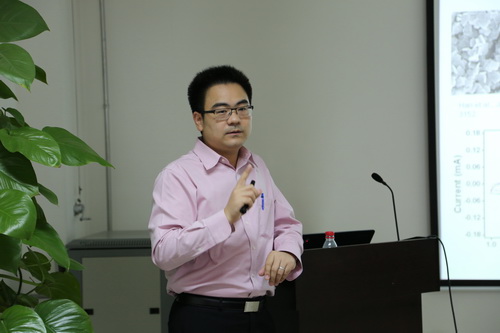
Dr. David Lou ( Image by ZHU Shihui )
Invited by Technical Institute of Physics and Chemistry, Chinese Academy of Sciences (TIPC,CAS), Dr. David Lou from Nanyang Technological University (NTU) visited TIPC CAS on June, 5 and gave an academic report entitled Nanostructured Metal Oxide Materials and Their Applications in Li-ion Batteries and Supercapacitors.
In the report, Dr. David Lou briefly discussed three types of metal oxides based on three different lithium storage mechanisms. They have synthesized hollow SnO2 nanostructures by both templating and template-free methods, and further engineered them into SnO2-carbon composite hollow structures to achieve significantly improved lithium storage properties. They also try to improve the lithium insertion properties of TiO2 by engineering the crystal facets in view of the fact that lithium insertion in TiO2 is anisotropic. In particular, anatase TiO2 in the form of nanosheet with exposed (001) facets is an ideal host structure for this purpose. We verified this hypothesis by both experimental measurement and theoretical calculation. They have also demonstrated the concept for conversion reaction compounds (e.g., Fe2O3) showing that the cycling performance can be improved by creating a porous/hollow structure. Lastly, I will briefly talk about some of our most recent works about mixed metal oxide materials for LIBs and supercapacitors.
David Lou received his B.Eng. (1st class honors) (2002) and M.Eng. (2004) degrees from the National University of Singapore. He obtained his Ph.D. degree in chemical engineering from Cornell University in 2008. For his excellent PhD thesis work, he was awarded the Austin Hooey Prize and the Liu Memorial Award. Right after graduation, he joined Nanyang Technological University (NTU) as an Assistant Professor. As a leading author, he has published over 140 papers in good journals, including about 40 papers in Angewandte Chemie-International Edition, Journal of the American Chemical Society, and Advanced Materials. His papers have been cited over 6000 times according to ISI web of science with an H-index of 40. He also holds several patents in nanostructured electrode materials for high-performance lithium-ion batteries. He is one winner of TR35@Singapore 2012 by MIT Technology Review. Recently, he also won the prestigious Young Scientist Award 2012 by Singapore National Academy of Science, and the Nanyang Award 2012 for research excellence by NTU. He is currently an Associate Editor for Journal of Materials Chemistry A.

